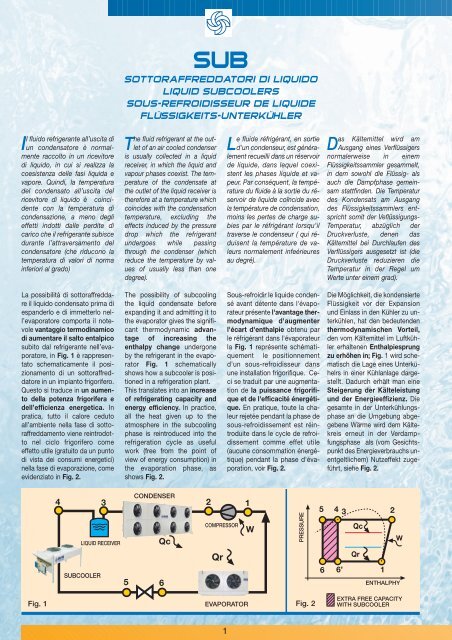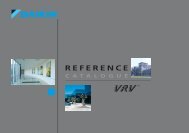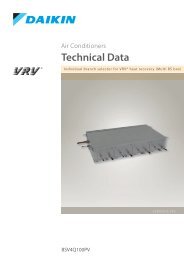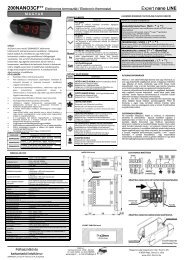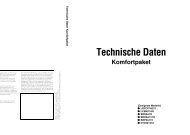sottoraffreddatori di liquido liquid subcoolers sous-refroidisseur de ...
sottoraffreddatori di liquido liquid subcoolers sous-refroidisseur de ...
sottoraffreddatori di liquido liquid subcoolers sous-refroidisseur de ...
You also want an ePaper? Increase the reach of your titles
YUMPU automatically turns print PDFs into web optimized ePapers that Google loves.
SUB<br />
SOTTORAFFREDDATORI DI LIQUIDO<br />
LIQUID SUBCOOLERS<br />
SOUS-REFROIDISSEUR DE LIQUIDE<br />
FLÜSSIGKEITS-UNTERKÜHLER<br />
Il fluido refrigerante all’uscita <strong>di</strong><br />
un con<strong>de</strong>nsatore è normalmente<br />
raccolto in un ricevitore<br />
<strong>di</strong> <strong><strong>liquid</strong>o</strong>, in cui si realizza la<br />
coesistenza <strong>de</strong>lle fasi <strong>liquid</strong>a e<br />
vapore. Quin<strong>di</strong>, la temperatura<br />
<strong>de</strong>l con<strong>de</strong>nsato all’uscita <strong>de</strong>l<br />
ricevitore <strong>di</strong> <strong><strong>liquid</strong>o</strong> è coinci<strong>de</strong>nte<br />
con la temperatura <strong>di</strong><br />
con<strong>de</strong>nsazione, a meno <strong>de</strong>gli<br />
effetti indotti dalle per<strong>di</strong>te <strong>di</strong><br />
carico che il refrigerante subisce<br />
durante l’attraversamento <strong>de</strong>l<br />
con<strong>de</strong>nsatore (che riducono la<br />
temperatura <strong>di</strong> valori <strong>di</strong> norma<br />
inferiori al grado)<br />
The fluid refrigerant at the outlet<br />
of an air cooled con<strong>de</strong>nser<br />
is usually collected in a <strong>liquid</strong><br />
receiver, in which the <strong>liquid</strong> and<br />
vapour phases coexist. The temperature<br />
of the con<strong>de</strong>nsate at<br />
the outlet of the <strong>liquid</strong> receiver is<br />
therefore at a temperature which<br />
coinci<strong>de</strong>s with the con<strong>de</strong>nsation<br />
temperature, exclu<strong>di</strong>ng the<br />
effects induced by the pressure<br />
drop which the refrigerant<br />
un<strong>de</strong>rgoes while passing<br />
through the con<strong>de</strong>nser (which<br />
reduce the temperature by values<br />
of usually less than one<br />
<strong>de</strong>gree).<br />
Le flui<strong>de</strong> réfrigérant, en sortie<br />
d'un con<strong>de</strong>nseur, est généralement<br />
recueilli dans un réservoir<br />
<strong>de</strong> <strong>liquid</strong>e, dans lequel coexistent<br />
les phases <strong>liquid</strong>e et vapeur.<br />
Par conséquent, la température<br />
du flui<strong>de</strong> à la sortie du réservoir<br />
<strong>de</strong> <strong>liquid</strong>e coïnci<strong>de</strong> avec<br />
la température <strong>de</strong> con<strong>de</strong>nsation,<br />
moins les pertes <strong>de</strong> charge subies<br />
par le réfrigérant lorsqu'il<br />
traverse le con<strong>de</strong>nseur ( qui réduisent<br />
la température <strong>de</strong> valeurs<br />
normalement infeérieures<br />
au <strong>de</strong>gré).<br />
Das Kältemittel wird am<br />
Ausgang eines Verflüssigers<br />
normalerweise in einem<br />
Flüssigkeitssammler gesammelt,<br />
in <strong>de</strong>m sowohl <strong>di</strong>e Flüssig- als<br />
auch <strong>di</strong>e Dampfphase gemeinsam<br />
stattfin<strong>de</strong>n. Die Temperatur<br />
<strong>de</strong>s Kon<strong>de</strong>nsats am Ausgang<br />
<strong>de</strong>s Flüssigkeitssammlers entspricht<br />
somit <strong>de</strong>r Veflüssigungs-<br />
Temperatur, abzüglich <strong>de</strong>r<br />
Druckverluste, <strong>de</strong>nen das<br />
Kältemittel bei Durchlaufen <strong>de</strong>s<br />
Verflüssigers ausgesetzt ist (<strong>di</strong>e<br />
Druckverluste reduzieren <strong>di</strong>e<br />
Temperatur in <strong>de</strong>r Regel um<br />
Werte unter einem grad).<br />
La possibilità <strong>di</strong> sottoraffreddare<br />
il <strong><strong>liquid</strong>o</strong> con<strong>de</strong>nsato prima <strong>di</strong><br />
espan<strong>de</strong>rlo e <strong>di</strong> immetterlo nell’evaporatore<br />
comporta il notevole<br />
vantaggio termo<strong>di</strong>namico<br />
<strong>di</strong> aumentare il salto entalpico<br />
subito dal refrigerante nell’evaporatore,<br />
in Fig. 1 è rappresentato<br />
schematicamente il posizionamento<br />
<strong>di</strong> un sottoraffreddatore<br />
in un impianto frigorifero.<br />
Questo si traduce in un aumento<br />
<strong>de</strong>lla potenza frigorifera e<br />
<strong>de</strong>ll’efficienza energetica. In<br />
pratica, tutto il calore ceduto<br />
all’ambiente nella fase <strong>di</strong> sottoraffreddamento<br />
viene reintrodotto<br />
nel ciclo frigorifero come<br />
effetto utile (gratuito da un punto<br />
<strong>di</strong> vista <strong>de</strong>i consumi energetici)<br />
nella fase <strong>di</strong> evaporazione, come<br />
evi<strong>de</strong>nziato in Fig. 2.<br />
The possibility of subcooling<br />
the <strong>liquid</strong> con<strong>de</strong>nsate before<br />
expan<strong>di</strong>ng it and admitting it to<br />
the evaporator gives the significant<br />
thermodynamic advantage<br />
of increasing the<br />
enthalpy change un<strong>de</strong>rgone<br />
by the refrigerant in the evaporator<br />
Fig. 1 schematically<br />
shows how a subcooler is positioned<br />
in a refrigeration plant.<br />
This translates into an increase<br />
of refrigerating capacity and<br />
energy efficiency. In practice,<br />
all the heat given up to the<br />
atmosphere in the subcooling<br />
phase is reintroduced into the<br />
refrigeration cycle as useful<br />
work (free from the point of<br />
view of energy consumption) in<br />
the evaporation phase, as<br />
shows Fig. 2.<br />
Sous-refroi<strong>di</strong>r le <strong>liquid</strong>e con<strong>de</strong>nsé<br />
avant détente dans l'évaporateur<br />
présente l'avantage thermodynamique<br />
d'augmenter<br />
l'écart d'enthalpie obtenu par<br />
le réfrigérant dans l'évaporateur<br />
la Fig. 1 représente schématiquement<br />
le positionnement<br />
d'un <strong>sous</strong>-refroi<strong>di</strong>sseur dans<br />
une installation frigorifique. Ceci<br />
se traduit par une augmentation<br />
<strong>de</strong> la puissance frigorifique<br />
et <strong>de</strong> l'efficacité énergétique.<br />
En pratique, toute la chaleur<br />
rejetée pendant la phase <strong>de</strong><br />
<strong>sous</strong>-refroi<strong>di</strong>ssement est réintroduite<br />
dans le cycle <strong>de</strong> refroi<strong>di</strong>ssement<br />
comme effet utile<br />
(aucune consommation énergétique)<br />
pendant la phase d'évaporation,<br />
voir Fig. 2.<br />
Die Möglichkeit, <strong>di</strong>e kon<strong>de</strong>nsierte<br />
Flüssigkeit vor <strong>de</strong>r Expansion<br />
und Einlass in <strong>de</strong>n Kühler zu unterkühlen,<br />
hat <strong>de</strong>n be<strong>de</strong>uten<strong>de</strong>n<br />
thermodynamischen Vorteil,<br />
<strong>de</strong>n vom Kältemittel im Luftkühler<br />
erhaltenen Enthalpiesprung<br />
zu erhöhen in; Fig. 1 wird schematisch<br />
<strong>di</strong>e Lage eines Unterkühelrs<br />
in einer Kühlanlage dargestellt.<br />
Dadurch erhält man eine<br />
Steigerung <strong>de</strong>r Kälteleistung<br />
und <strong>de</strong>r Energieeffizienz. Die<br />
gesamte in <strong>de</strong>r Unterkühlungsphase<br />
an <strong>di</strong>e Umgebung abgegebene<br />
Wärme wird <strong>de</strong>m Kältekreis<br />
erneut in <strong>de</strong>r Verdampfungsphase<br />
als (vom Gesichtspunkt<br />
<strong>de</strong>s Energieverbrauchs unentgeltlichem)<br />
Nutzeffekt zugeführt,<br />
siehe Fig. 2.<br />
4<br />
LIQUID RECEIVER<br />
SUBCOOLER<br />
3<br />
CONDENSER<br />
5 6<br />
Qc<br />
2<br />
COMPRESSOR<br />
Qr<br />
1<br />
W<br />
PRESSURE<br />
5<br />
6<br />
4 3<br />
6’<br />
2<br />
Qc<br />
W<br />
Qr<br />
1<br />
ENTHALPHY<br />
Fig. 1 EVAPORATOR<br />
Fig. 2<br />
EXTRA FREE CAPACITY<br />
WITH SUBCOOLER<br />
1


